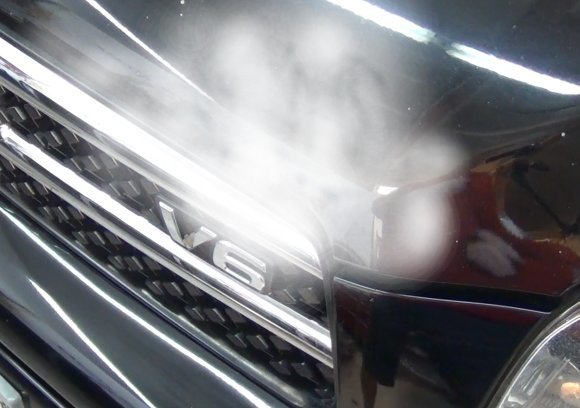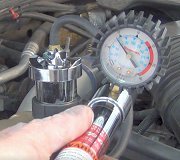I have a suspicion with the original diagnosis. Ford has had problems in the past when excessive engine oil leaked into the starters. That caused the internal brushes to deteriorate, crumble, and wear out much faster than normal. The typical observation is you'll hear the single, rather loud clunk the starter makes when it first engages, but it won't spin the engine. People often get them working again for a while by tapping on the starter with a broom handle. That can jar it just enough that two of the four brushes make a good enough contact to start the starter cranking the engine, then it will continue to crank at least until you release the ignition switch, and it might work normally for the next dozen times you start the engine.
Engine coolant causes less of a problem. That is fifty percent water, and if water caused this problem, it would happen to every car that is driven in rain. In fact, the only problem that water causes is the drive gear can rust to the shaft and then fail to pop out to engage the engine, but that only happens on cars that are stored for months without having their engines started periodically. For those of us who drive our cars regularly, water doesn't cause many problems.
Another common problem on some older Ford models was the fat positive battery cable that runs to the starter would corrode away right next to where it bolts to the starter, under the cable's insulation where you can't see it. That can also cause you to hear the single loud clunk during engagement, but the starter doesn't spin the engine. That is usually an intermittent problem, and you will often get it to work right after wiggling or tugging on that cable a little. The best way to identify that is to check for the constant 12 volts right on the starter's fat terminal, with a test light. If you see that test light turn off when a helper tries to crank the engine, that is proof of a bad cable or a bad connection at the battery. We can discuss that more and how to narrow it down if that becomes necessary.
As for the coolant reservoir, coolant expands when the engine warms up, and it flows into the reservoir. Later, when the engine cools down, that coolant gets drawn back into the engine. When the reservoir has a leak, coolant that gets pushed into it is lost, then, when the engine cools down, only air is drawn back in. Most of the time you'll never even know that happened except on those car models that have a "Low Coolant" warning light. As far back as the late '60s, most car and truck models never even came with those reservoirs. If you looked in the radiator when the engine was cold, the coolant level was always down an inch or two, and that was normal. The point is, once you lost some coolant, that leakage will not continue unless you add some. When the engine warms up, it is that air that gets pushed into the reservoir, not additional coolant.
Given that coolant leakage is not going to be an ongoing or continuous problem, and that coolant doesn't really damage a starter, I suspect there is some other reason for the intermittent failure to crank the engine. If we need to pursue this further, you'll need an inexpensive test light, not one of the new fancy ones with digital readouts and electronics inside. You can find a perfectly fine test light for less than ten bucks at Harbor Freight Tools, Walmart, or any hardware store. Here's a link to an article on how to use it:
https://www.2carpros.com/articles/how-to-use-a-test-light-circuit-tester
The goal with this test is to get the failure-to-crank problem to occur, then to be careful to not bump or wiggle anything. We need it in the defective state so there is something to diagnose.
The best place to find a replacement reservoir is at a salvage yard. Unless this is a common problem on this model that I'm not aware of, this type of failure is not common, so I would feel confident that a used one would be satisfactory. The only thing I can think of when your mechanic referred to a "plunger" would be a float and level sensor or switch that turns on that "Low Coolant" warning light. If your car has that feature, those parts are going to come as part of the reservoir assembly. That would include a two-wire electrical connector. Other than that, a few bolts hold the reservoir in place, then one rubber hose connects to it.
Friday, May 15th, 2020 AT 4:54 PM


